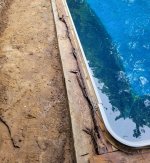2020 Code Language:
680.26(B)(2) Perimeter Surfaces. The perimeter surface to be bonded shall be considered to extend for 1 m (3 ft) horizontally beyond the inside walls of the pool and shall include unpaved surfaces and other types of paving. Perimeter surfaces separated from the pool by a permanent wall or building 1.5 m (5 ft) in height or more shall require equipotential bonding only on the pool side of the permanent wall or building. Bonding to perimeter surfaces shall be provided as specified in 680.26(B)(2)(a), (B)(2)(b), or (B)(2)(c) and shall be attached to the pool reinforcing steel or copper conductor grid at a minimum of four points uniformly spaced around the perimeter of the pool. For nonconductive pool shells, bonding at four points shall not be required.
(a) Structural Reinforcing Steel. Structural reinforcing steel shall be bonded in accordance with 680.26(B)(1)(a).
(b) Copper Ring. Where structural reinforcing steel is not available or is encapsulated in a nonconductive compound, a copper conductor(s) shall be utilized where the following requirements are met:
(1) At least one minimum 8 AWG bare solid copper conductor shall be provided.
(2) The conductors shall follow the contour of the perimeter surface.
(3) Only listed splicing devices or exothermic welding shall be permitted.
(4) The required conductor shall be 450 mm to 600 mm (18 in. to 24 in.) from the inside walls of the pool.
(5) The required conductor shall be secured within or under the perimeter surface 100 mm to 150 mm (4 in. to 6 in.) below the subgrade.
(c) Copper Grid. Where structural reinforcing steel is not available or is encapsulated in a nonconductive compound, copper grid shall be utilized where the following requirements are met:
(1) The copper grid shall be constructed of 8 AWG solid bare copper and be arranged in accordance with 680.26(B)(1)(b)(3).
(2) The copper grid shall follow the contour of the perimeter surface extending 1 m (3 ft) horizontally beyond the inside walls of the pool.
(3) Only listed splicing devices or exothermic welding shall be permitted.
(4) The copper grid shall be secured within or under the deck or unpaved surfaces between 100 mm to 150 mm (4 in. to 6 in.) below the subgrade.
2017 Code Language:
680.26(B)(2) Perimeter Surfaces. The perimeter surface to be bonded shall be considered to extend for 1 m (3 ft) horizontally beyond the inside walls of the pool and shall include unpaved surfaces and other types of paving. Perimeter surfaces separated from the pool by a permanent wall or building 1.5 m (5 ft) in height or more shall require equipotential bonding only on the pool side of the permanent wall or building. Bonding to perimeter surfaces shall be provided as specified in 680.26(B)(2)(a) or (2)(b) and shall be attached to the pool reinforcing steel or copper conductor grid at a minimum of four (4) points uniformly spaced around the perimeter of the pool. For nonconductive pool shells, bonding at four points shall not be required.
(a) Structural Reinforcing Steel. Structural reinforcing steel shall be bonded in accordance with 680.26(B)(1)(a).
(b) Alternate Means. Where structural reinforcing steel is not available or is encapsulated in a nonconductive compound, a copper conductor(s) shall be utilized where the following requirements are met:
(1) At least one minimum 8 AWG bare solid copper conductor shall be provided.
(2) The conductors shall follow the contour of the perimeter surface.
(3) Only listed splices shall be permitted.
(4) The required conductor shall be 450 mm to 600 mm (18 in. to 24 in.) from the inside walls of the pool.
(5) The required conductor shall be secured within or under the perimeter surface 100 mm to 150 mm (4 in. to 6 in.) below the subgrade.







